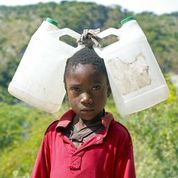If you want to see some moving, environmentally-conscious, high-quality photography, the Environmental Photographer of the Year 2013 exhibition is for you.
Currently on display in the wilds of Grizedale Forest in the Lake District, the competition, which is open to people of all ages and nationalities, has gained a prestigious reputation since it was launched in 2007 by the Chartered Institute for Water and Environmental Management (CIWEM).
This year’s selection of the 3,000 plus entries presents a thought-provoking mosaic of life at the margins of society and how our material demands – and what we throw away – affect the environment (NB: this is not a wildlife photography competition). Consequently, many of the photographs depict extremes: we see people who don’t have very much scraping a living, and we wonder at the locations some call home. Of course, photography thrives on such material because it offers a visceral contrast to our more comfortable lives. In addition, as an art form that seeks to please the eye, photography is sometimes guilty of inadvertently beautifying states of material deprivation, transgressing its documentary role. However, if a well-composed photo can highlight a cause then perhaps this sacrifice to art is worthwhile.
 Looking at these photographs stimulates a variety of emotions. We immediately sympathise with GMB Akash’s image Decaying Earth, which shows a young man and a boy working on a smouldering rubbish dump in Bangladesh; the boy is covering his face from the smoke – we dare not imagine its chemical composition. Similarly, Javier Arcenillas’s Shipbreakers #04 shows workers in a shipbreaking yard using only their bare hands for dismantling. While it’s impossible for us to imagine the adversity of such working conditions, these photos go some way in portraying stark and uncomfortable realities.
Looking at these photographs stimulates a variety of emotions. We immediately sympathise with GMB Akash’s image Decaying Earth, which shows a young man and a boy working on a smouldering rubbish dump in Bangladesh; the boy is covering his face from the smoke – we dare not imagine its chemical composition. Similarly, Javier Arcenillas’s Shipbreakers #04 shows workers in a shipbreaking yard using only their bare hands for dismantling. While it’s impossible for us to imagine the adversity of such working conditions, these photos go some way in portraying stark and uncomfortable realities.
Steve Brockett’s Discarded Plastic testifies to the environmental impact of this ubiquitous by-product of mass consumerism. At first sight, the photograph appears to depict the tesserae of a Roman mosaic, but closer inspection reveals an aerial shot of hundreds of plastic containers clinging together on a water deposit in Spain. It’s a prominent reminder that we’re living in a plastic age, and that this useful substance is completely at odds with nature, stubbornly refusing to partake in the decomposition process.
The effect of modern communication is also considered. Steve Morgan’s Trains shows a seemingly infinite expanse of interconnecting tracks at Frankfurt Central Station, Germany’s busiest railway station, while in Rob Whitworth’s Electricians, two engineers grapple heroically with an intimidating tangle of electrical cable. These photos in particular seem fairly innocuous at first on account of their familiar subjects, but considered in an environmental context they begin to look incongruous, conveying a real sense of the abstractness of our infrastructures and their physical imposition on the environment. 
One of the most beautiful and remarkable images on display is Florian Breuer’s Quiver Trees. Taken in Namibia, it shows the trees (so-called because tribesmen use them to make arrow quivers) silhouetted against a star-laden night sky, with the splendid arc of the Milky Way clearly visible. Equally engaging is Max Wolens’s Serenity, a relatively simple shot which exploits a limited colour palette to great effect by contrasting the deep orange of a Buddhist monk’s robe and shapely, whitewashed pillars with a dark background.
The winning photo, Michele Palazzi’s Gone with the Dust #02, shows a young boy, his sister and a distant camel braving a sandstorm in Mongolia’s Gobi Desert. Though it’s a well-balanced shot with depth, it isn’t an obvious winner for your reviewer. My favourite has to be Alessandro Grassani’s Mongolia #01 which shows a little girl ascending a hill in Ulaanbaatar, the capital of Mongolia. Here, poverty has increased in recent years because of harsh winters known as ‘dzud’, which have forced shepherds and their families to migrate to the capital to find work. The photo works by using scale to create a sense of uncertainty. The tiny girl appears to be protected from the dangers of the outside world as she follows the line of high slum fencing, but we can see the city and the brooding mountains beyond, making us fear for her future.
Like good books or great music, certain photographs take a permanent place in our consciousness as we come to know them and understand their layers. Such is the case with this stimulating exhibition, which brings to our attention the beauty of the earth while offering up a sobering perspective of our relationship with it.
Review by Matthew Graham
 What: Environmental Photographer of the Year 2013 Exhibition
What: Environmental Photographer of the Year 2013 Exhibition
Where: Grizedale Forest Visitor Centre, Cumbria
When: until September 1, 2013
More info: http://www.ciwem.co.uk/competition-and-awards/environmental-photographer.aspx#ad-image-98; http://www.grizedalesculpture.org/index.php/current-projects/76-environmental-photographer-of-the-year




